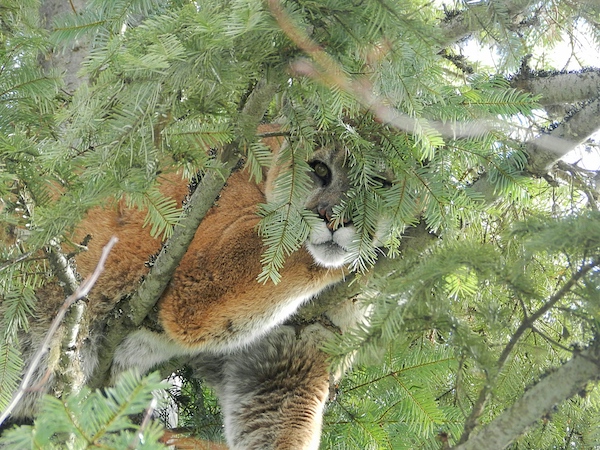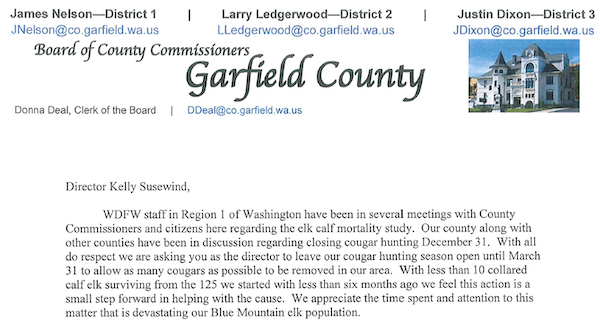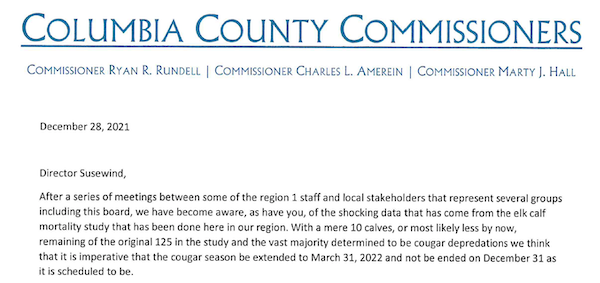
Counties Ask WDFW To Extend Blues Lion Season Due To Elk Losses
Commissioners from all four Southeast Washington counties are asking state hunting managers to essentially extend general mountain lion season by three months to address very high documented elk calf losses there.
“With all do (sic) respect we are asking you as the director to leave our cougar hunting season open until March 31 to allow as many cougars as possible to be removed in our area,” state Garfield County Commissioners James Nelson, Larry Ledgerwood and Justin Dixon in a late December letter to WDFW’s Kelly Susewind.

Hunting is actually open right now, though under a quota system with 10 to 16 cougars still available for harvest in this rugged, snowbound region, but it’s a message that was echoed unanimously in late 2021 by Asotin, Columbia and Walla Walla Counties’ boards of commissioners as well.
They’re all reacting to last month’s news that just 11 of 125 Blue Mountains elk calves captured and collared last spring were known to be alive through November 29, an “exceptionally low” survival rate; more typical rates range from 57 down to 17 percent.
And with winter mounting in this part of the state, death continues to stalk the herd. WDFW reported this morning that there are now just nine calves with functioning telemetry devices, while a 10th dropped its collar. (Seven others also lost theirs earlier in 2021.)
The calves are part of a study into why the Blue Mountains herd has declined from north of 5,700 elk as recently as 2016 to roughly 3,600 last year and is now 36 percent below the population objective of 5,500, despite sharp reductions in cow tags, which have failed to spark a rebound.
It’s becoming more and more clear that predation, and specifically by cougars, is one strong factor in the sharp drop – the harsh winter of 2016-17 is another, along with drought – and accounted for at least 77 calf mortalities as of the end of November, with 54 killed by the big cats.

“We share a common concern with our constituents and were shocked at the most recent elk calf mortality study. Coupled with other data on elk mortality, we have grave concerns about the apparent inadequacy in the protection of the elk and elk calves to date,” wrote Asotin County Commissioners Chris Seubert, Brian Shinn and Chuck Whitman to WDFW, according to the Lewiston Tribune, which first reported on the existence of the counties’ letters yesterday.
Along with the 54 calves killed by cougars, nine others were taken down by bears, four by either bears or cougars, four by an unknown predator, three by coyotes, two by wolves and one by a bobcat.
Wolves can’t be hunted in Washington except by members of two northeast tribes on and near their reservations, and the Fish and Wildlife Commission recently paused the spring bear hunt in the Blues and elsewhere in the state for 2022.
“We feel by extending the cougar season to March 31, 2021 it will be a small step forward in helping with the elk population. We appreciate the time spent on this study and the attention to the matter that is devastating our Blue Mountain elk population,” add Walla Walla County Commissioners Gregory Tompkins, Todd Kimball and Jennifer Mayberry.

Cougar season is open right now across the state through the end of April, but this “late hunt” that began January 1 is also subject to being shut down earlier if harvest guidelines for sets of game management units are reached.
In the Blues, harvest guidelines range from five to six cougars in a group of GMUs along the Grande Ronde River and in the Wenaha-Tucannon Wilderness, to six to seven in units on the northeast flanks of the Blues, to seven to nine in units on the northwest side and foothills of the range.
The somewhat squishy numbers reflect 12-16 percent of adult population levels.
“I realize that the quotas are set with what is believed to be good science but with the depredation numbers as well as the frequent and numerous sightings, particularly by coon hunters and other nighttime spot lighters, it is evident that the local cougar populations have been underestimated and the quotas are unrealistically low. For these reasons, we are respectfully asking that you extend the cougar season so that sportsman (sic) can reduce the numbers as an effort to help this struggling elk herd as well as other game animals and domestic animals,” said Columbia County Commissioners Ryan Rundell, Charles Amerein and Marty Hall.
A Blue Mountains cougar research project that wrapped up in 2013 found densities of 3.02 mature cats per 100 square kilometers, or 38.6 square miles, “considerably higher than reported elsewhere in the state of Washington, which averaged 1.5 – 1.7 adult cougars/100 km.”
The letters amount to a sharply different tack than some members of the Washington Fish and Wildlife Commission expressed early last month, saying the elk herd objective should be lowered and hunting be reduced instead. The calf study and an ongoing “literature assessment” by WDFW are pathways towards potential cougar removals.
WDFW Region 1 Manager Steve Pozzanghera responded to Columbia County leaders in late December to say that all three of the region’s cougar management sets were below their harvest guidelines, with six killed on the northwest side of the mountain range, two in the Wenaha-Grande Ronde units and zero on the northeast side through the 29th, “and as such cougar hunting seasons will remain open into January 2022.”
A total of 18 to 24 cats can be killed in the Blues during the early and late seasons.
“Regional and Headquarters Wildlife Program staff will continue to monitor cougar harvest in these three Blue Mountain hunt areas and will coordinate with the Director’s Office regarding your request to keep the seasons open through March 31, 2022. This may or may not be an issue and will depend on additional adult cougar harvest occurring. We will keep you updated on cougar harvest and any decisions associated with season closure,” Pozzanghera also wrote.
Hunters are allowed one lion each license year and need to have their kills sealed by WDFW within five days of harvest. Hound hunting was banned by a 1990s initiative. It’s illegal to kill kittens with spots, which morph to bars after four to five months of age, or adults with spotted kittens.
The early cougar hunt across the state runs September 1 through December 31 without a guideline under a general season.
During the late season, hunters also must call (866) 364-4868 or go to a special WDFW webpage to check on quotas, as well as report any animal they take within 72 hours.
For cougar hunting tips, check out ODFW’s handy “10 ways to be a better cougar hunter” post.

Cougar management in Washington has become increasingly contentious in recent years.
WDFW’s commission in 2015 raised the harvest rate in wolf-inhabited areas of Eastern Washington from 12-16 percent of the population to 17-21 percent, a move that drew the ire of predator advocates who got Governor Jay Inslee to tell them to reverse the move.
And in Southcentral Washington, the Klickitat County Sheriff’s Office’s removal of cougars for public safety reasons is likely the inspiration behind a bill prefiled in Olympia to strip counties of the ability to use dogs to pursue lions, bears and bobcats to protect people and/or livestock.
State and federal officials would still be allowed to do so under SB 5613, sponsored by Senators Kevin Van De Wege, who chairs the upper chamber’s natural resources committee, and Christine Rolfes, also a member of the panel. Both are Westside Democrats.
